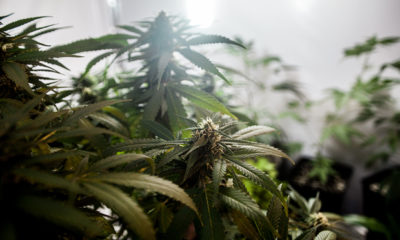
Economics
Shame of the Cities: Why Marijuana Legalization Isn’t Buying CA Nice Things
High taxes and hundreds of cities and counties refusing to legalize commercial cannabis sales means California isn’t sitting on a pile of marijuana money.
Justine Wiley is a registered nurse in Santa Cruz County, California, a stretch of beaches and redwood-dotted mountains about two hours south of San Francisco. For the past year or so, Wiley has been traveling throughout the county working with low-income first-time mothers, troubleshooting all the various issues raising a child creates.
Visits from a do-it-all nurse-slash-social worker are the kind of services mothers take for granted in social democracies in Europe. This is simply what the state does. In California’s case, Wiley’s house visits started after state voters legalized marijuana in Nov. 2016. Taxed sales of recreational cannabis netted Santa Cruz County the $350,000 that’s funding Wiley’s road trips.
And yet what Santa Cruz is doing is unique. Using cannabis tax money to fund social services was one of the promises made by the backers of Prop. 64. Yet two and a half years after the vote, and almost 18 months into the era of licensed commercial sales, a relatively well-off county having extra money to provide its citizens nice things is a notable-enough development to warrant mention in a recent article in the San Jose Mercury News.
Other cities and towns in California just don’t have it — because nobody has it.
Prop. 64 promised $1 billion in new state revenue. In order to reap such bounty, $7 billion in annual sales would be required. That’s a lot of weed, but it seems feasible — at least in an uncomplicated world. Colorado, with 5.6 million residents, sells more than $1 billion worth of cannabis a year; California, with nearly 40 million people, could probably outdo Colorado by seven times.
The complication is California’s, and the many cities and counties that decided commercial cannabis was some kind of menace. Prop. 64 allowed local governments final say over whether legalized cannabis would be allowed within their jurisdictions. And nearly two-thirds of local governments do not allow commercial sales or licensed cultivation. Thus they get no money — but they are also starving the state, as the Mercury News observed.
Former Gov. Jerry Brown, under whose cantankerous eye California finally regulated cannabis on a state level, projected state sales tax revenue at $630 million for the first year. The state recorded only $345 million in 2018, the Mercury News reported.
Current Gov. Gavin Newsom, Prop. 64’s most prominent advocate, initially guessed that California would rake in $355 million in the current fiscal year, with $515 million the year after. Getting better, but still half of what was promised. But on second thought, even that was too rosy — on May 1, in revised budget figures, the state scaled back its projections to $288 million for the current year and $359 million for the next. Even less than what the first year brought in, with temporary licensing and with many cities and counties who do allow sales not yet passing the necessary laws to allow it.
What’s wrong, who is to blame — and how can this be fixed? The prohibition mindset, partially, but Prop. 64 probably also promised too much — and state lawmakers allowed themselves to get too greedy too quickly.
As many as 6,000 legal and licensed commercial retail outlets were supposed to open, as the San Jose Mercury News recently observed. As of the end of May, just shy of 1,000 dispensary licenses have been issued by the state, the newspaper reported. Local bans play a role here. Even where licensed dispensaries are banned, there remains demand for cannabis, the world’s favorite illicit drug. Therefore, there is incentive for numerous unlicensed dispensaries, including both storefronts and delivery services, to run risks and sell weed like they always did.
And there’s really not much that risk. Off-book delivery services may always be a thing — how do you prevent anyone with internet, a phone, and some weed from advertising the service — but the resilience of unlicensed storefronts, and the inability of the authorities to protect the taxpaying market from such unfair competition, is a very legitimate concern.
California also taxes cannabis sales heavily. The tax burden is 40 percent or higher in some jurisdictions, depending on how crazy the local taxes are. As authorities in Colorado figured out early, if taxes are too damn high nobody will buy legal weed and one of the purposes of legalization is defeated. Remember that Prop. 64 wasn’t sold to voters on a social-justice or “do the right thing” argument: It was a cynical-hysterical “this will bring us money while keeping the kids safe” justification.
Compare this again to experiences in Colorado. Perhaps most famously, the town of Edgewater, on Denver’s western border, was able to repave streets and fund a new civic center with a library, gym, and City Hall with cannabis tax revenue — because it allowed dispensaries to operate past 7 p.m., the hour when sales in Denver were required to end.
The solution seems simple and obvious to libertarians and statists alike: Allow sales at a reasonable rate and you will earn money. Why this lesson is lost on California communities is a complicated question, but the ramifications are obvious. They’re right there in the dwindling figures in the ledger.
TELL US, do you pay tax on your cannabis?
























